 Are you planning to set up a WordPress-based e-commerce site, or sell goods and services to an international audience? If so, then it’s a great idea to think about providing your potential customers with a currency conversion feature.
Are you planning to set up a WordPress-based e-commerce site, or sell goods and services to an international audience? If so, then it’s a great idea to think about providing your potential customers with a currency conversion feature.
Currency converting tools let your prospective customers translate international currency amounts into their home currency at the point of sale. It also allows customers to view the exact amount their card or PayPal account will be charged, expressed in their home currency.
The obvious advantage of displaying currency conversion on your site is that it lets visitors see and understand pricing in foreign countries in their own home currency, and makes it easier for visitors to work out their costs and expenses.
If your site is powered by WordPress, you can add currency conversion via a plugin to WordPress, allowing your prospective customers to easily perform currency conversions to determine the cost of your products.
Currencyr
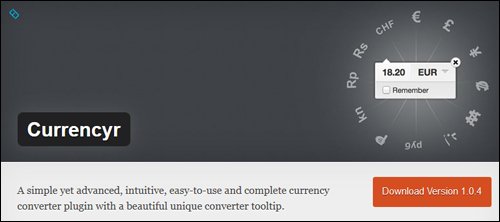
Currencyr is a simple yet advanced, intuitive, easy-to-use and complete currency converter WordPress plugin with a unique and attractive converter tooltip. It’s also free to install and use on your WP website.
Useful plugin features include:
- Inline converter
- Supports various exchange rates providers, like Yahoo! & European Central Bank
- Support database cache driven for fast response
- Widgetized currency table and converter
- Can be integrated with a number of online shopping plugins like WooCommerce, WP-eCommerce and Easy Digital Downloads.
- Automatic local currency determination
- Supports full translations
Note: The Currencyr plugin requires PHP 5.3.0 or later. Do not install this plugin if you are running an older version of PHP on your server. Alternatively, ask your web host to update your PHP.
***
You can install the currency conversion plugin from your WP admin area by typing in “currencyr” into the Plugins search field and clicking “Install Now” …
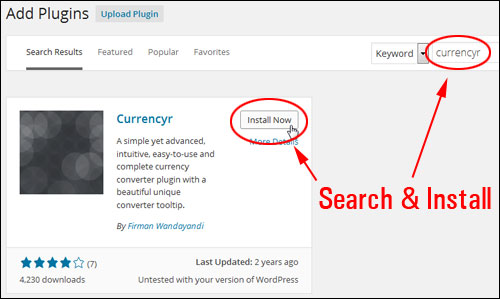
After the plugin has been installed and activated, you can visit the plugin’s settings by selecting Currencyr from your admin user menu …
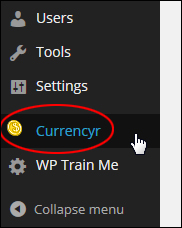
The plugin settings section provides many configuration settings …
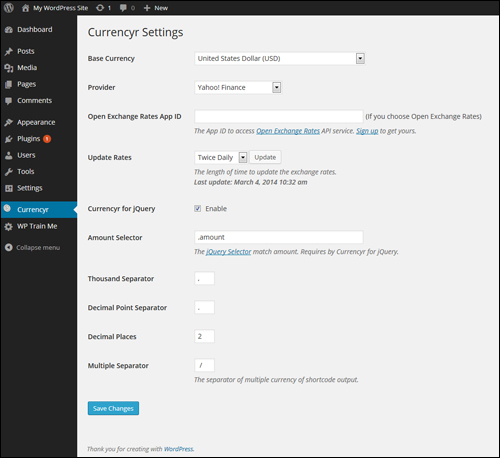
For example, you can select a base currency from a drop-down menu. The default option is ‘USD’ …
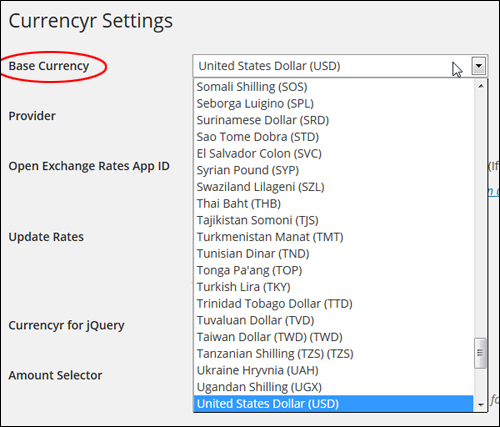
Similarly, you can specify which data provider you want to use from the drop-down menu in the Provider section. The default option is ‘Yahoo! Finance’, but you can choose another option, like European Central Bank or Open Exchange Rates …

Note: If you choose Open Exchange Rates as your provider, you will need to enter an API (Application Programming Interface) ID …

You can choose how frequently you want to update the exchange rates by specifying an option from the Update Rates drop-down menu …

The plugin uses jQuery, which allows web developers to add things like animation effects to web applications (like WP plugins).
Unless there is a reason to modify the jQuery settings, leave this option alone …

Configure the remainder of the settings according to your own needs and click ‘Save Changes’ when done …
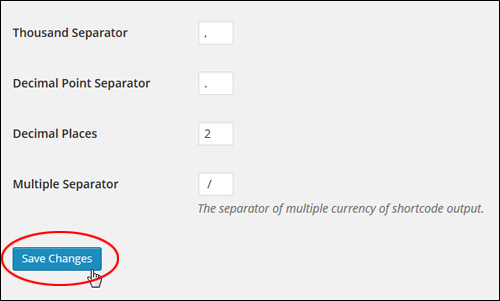
After your plugin settings have been configured, you can start adding currency conversion to any WP page or post using a shortcode.
See the ‘Additional Plugin Notes’ section below to learn how to use currency codes (e.g. USD, NZD, CAD, etc …) in this plugin.
How To Use Currencyr Shortcodes
You can insert currency conversion into WP posts, pages and widgets with no web coding skills or knowledge using shortcodes.
Let’s take a look at some examples of currency shortcodes that you can add to pages and posts:
Let’s say that you sell goods on your website for a fixed price (e.g. $175) in US Dollars (USD), and you would also like to display the amount converted into British pounds (GBP) on your product information page.
To display this information, simply add the following shortcode to your page content …

Note: You can also display prices in dollars and cents (for example, 165.49, 22.00, 295.75, etc …)
The example below shows how your shortcode looks after being inserted into a post or page …
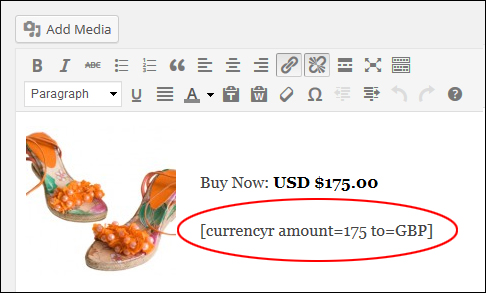
After publishing the page or post, your currency conversion will then display like this …
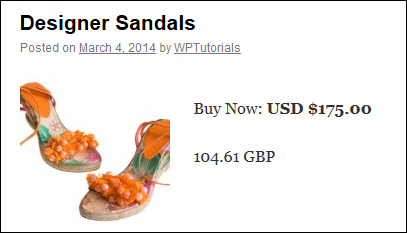
Using the above example, let’s also display the same amount into multiple currency formats.
To do this, use following shortcode (you can add as many currency symbols as you like separated by vertical pipes) …

The example below now shows how the shortcode looks when you add it to a post …

Once the information has been published, the currency conversion will then appear as you can see below …
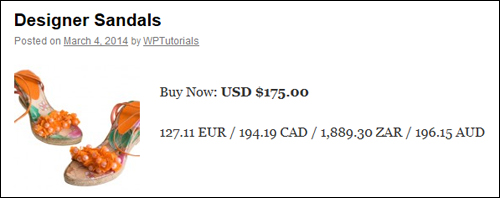
See the ‘Additional Plugin Notes’ section at the bottom of this tutorial to learn more about changing the currency separator symbol within this plugin.
Now, suppose you want to specify a different base currency than the one set as the default.
For example, if you have specified your default base currency as EUR and you have a section on your website targeted to non-European customers (e.g. Australia or Canada), you can change the base currency using the following shortcode …

The screenshot below now shows how the above shortcode appears when inserted into a post …
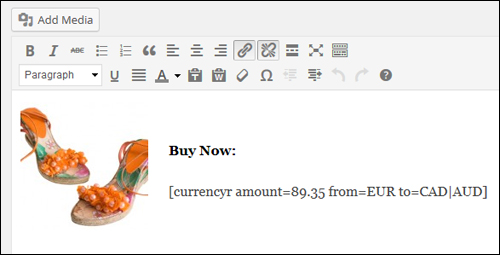
After publishing your information, the currency conversion will then display as seen below …
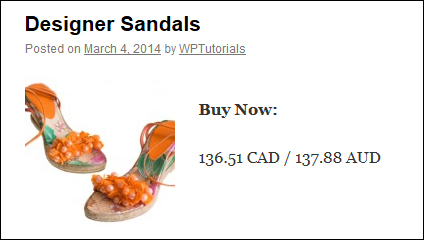
Widget
You can also insert currency conversion into your website’s sidebar section using the plugin’s widget.
To add the currency converter to your sidebar, choose Appearance > Widgets from your WordPress user admin menu …
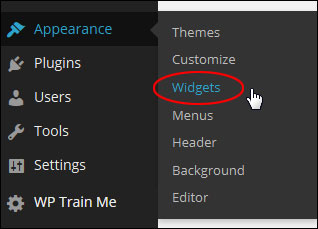
In the Widgets > Available Widgets area find the ‘Currencyr’ widget and add it to the ‘Active Widgets’ area …
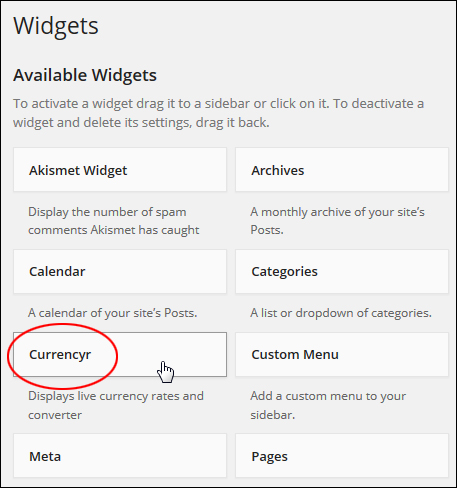
Configure the widget settings as shown in the example below (add any currency codes you want displaying on your widget separated by a comma), and click Save to update your settings …
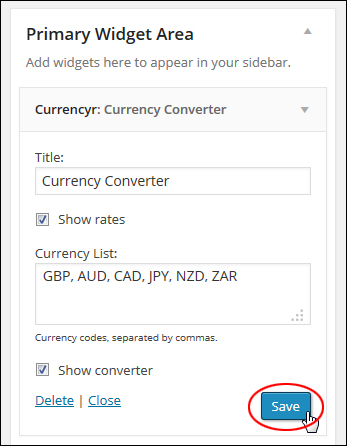
Your currency conversion tool will now display on the sidebar menu with the settings you have specified …
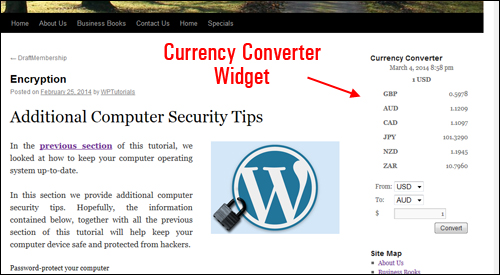
Additional Plugin Notes
Here are some additional notes and useful information about using the Currencyr plugin.
Currency Separator
The Currencyr plugin allows you to specify a symbol of your choice to display as the currency separator when using multiple currencies.
You can change the symbol in the Multiple Separator settings section.
So, for example, entering the default symbol “/” (forward slash) …

Separates all your currency values with the forward slash as you can see in the example below …
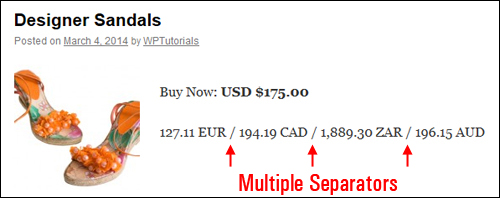
If you modify this symbol and update your settings …

Your site visitors will see the new symbol display as the currency separator …
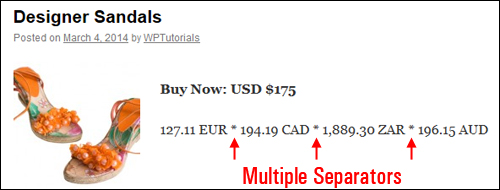
E-Commerce Software Integration
As described earlier, the Currencyr plugin can be integrated with various WordPress-compatible e-commerce plugins like WooCommerce, WP-eCommerce, Shopp, and Easy Digital Downloads …
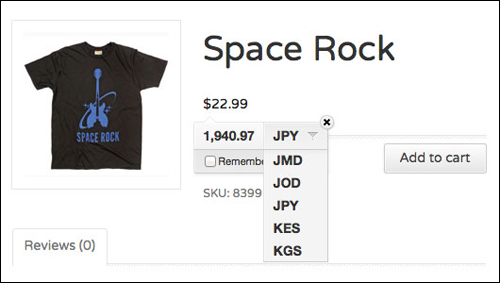
(above image sourced from plugin website)
And there you have it! Now you know how to easily add a currency converter to your WordPress website.
To learn more about WordPress e-commerce plugins, see the tutorial below:
***
"If you're new to WordPress, this can stand on its own as a training course and will stay with you as you progress from beginner to advanced and even guru status." - Bruce (Columbus, Ohio)